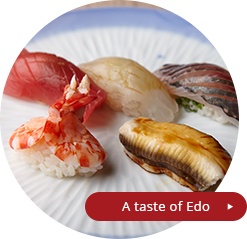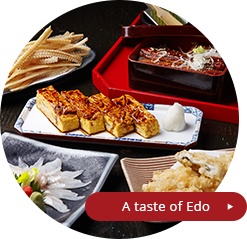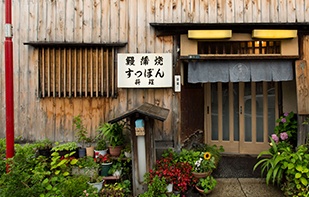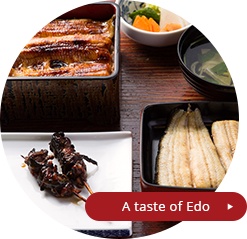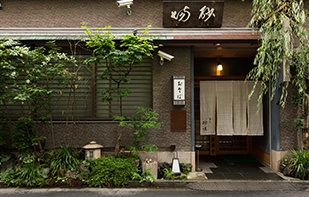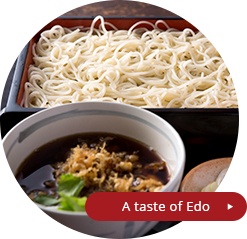Edomae relief from
the summer heat
When the Japanese summer becomes blistering hot, there's no better relief than donning a yukata and dining out at one of Tokyo's finest Edomae (old Tokyo style) restaurants. You can lessen your fatigue with Edomae eel and horsemeat, cool your palate with slippery soba noodles or feast on always delicious seasonal sushi. There's something satisfying for everyone at these renowned Edomae restaurants.
 Kizushi
Traditional Edomae sushi and atmosphere
Kizushi
Traditional Edomae sushi and atmosphere
 Nihonbashi Tamai
Nihonbashi TamaiMain Store Immerse yourself in anago artistry
 Myojinshita
Myojinshita Kandagawa Shiten The choice of unagi aficionados
 Muromachi Sunaba
Soba for soba lovers
Muromachi Sunaba
Soba for soba lovers
Kizushi喜寿司
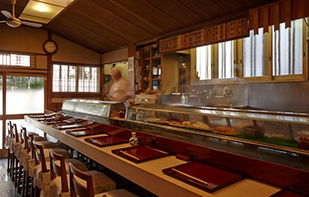
Phone: 03-3666-1682
- Address:
- 2-7-13 Nihonbashi Ningyo-cho, Chuo-ku, Tokyo
- Open:
- Mondays to Fridays Lunch 11:45-14:30, Dinner 17:00 -21:30
Saturdays 11:45- 21:00 - Closed:
- Sundays and holidays (when holidays fall on a Monday, the shop will only be open for lunch on the Sunday before)
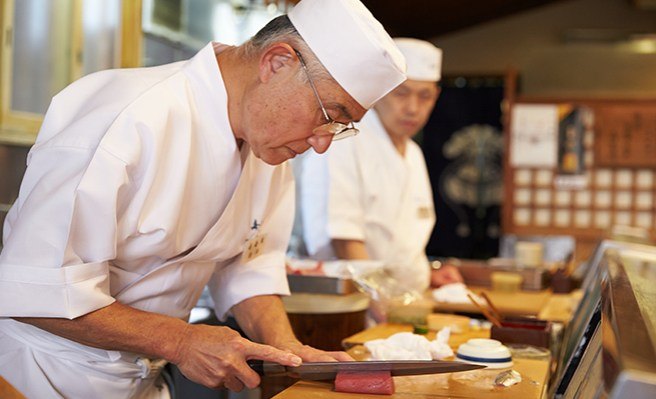
Authentic Edomae sushi requires meticulous preparation. According to Yui, who preserves his predecessors' techniques, it takes more than ten years to master these preparation skills.
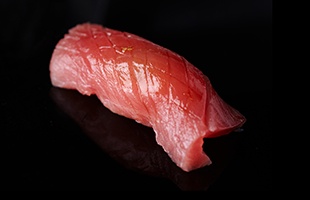
Tuna from the Chef’s Choice course (10,000 JPY). Only top-grade bluefin tuna from leading fishing grounds like Yamada Bay and Iwasaki Port is served at Kizushi.
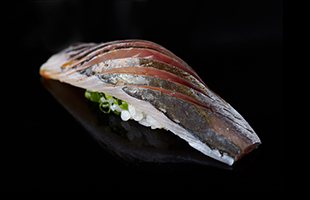
Aji (horse mackerel) from Kagoshima Prefecture, served traditionally with fresh ground ginger and chives. The fishing ground depends on the season.
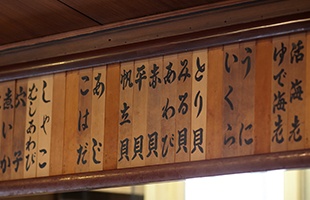
The menu changes dramatically with the season. Kizushi only serves naturally caught seafood to ensure full flavor and utmost freshness.
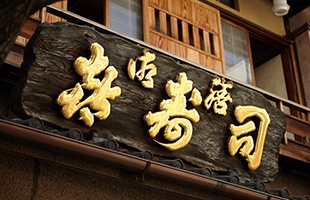
Kizushi was established in 1923 and rebuilt right after WWII. The aging facade adds character to its traditional atmosphere.
Traditional Edomae sushi and atmosphere
When you slide open the door at Kizushi restaurant, the first thing you notice is a solid wood counter stretching 22 feet across the room. Made of Japanese cypress from Kiso, it has lightened with age, lending a dignified air to the classically refined room that inspires customers to lower their voices and sit up straight. For over 90 years, Kizushi has served the same traditional Edomae sushi in the same location.
Sushi preparation at Kizushi is as traditional as its architecture. Lean tuna toppings are slit for easy consumption. Boiled shrimp toppings cover rice concealing oboro (shredded, pink-dyed fish). Aji (horse mackerel) seasonings lie beneath the meat. Even the sauce on anago (conger eel) is caramelized the traditional way. These Edomae basics are no longer observed in many sushi restaurants.
Ryuichi Yui, Kizushi's third-generation owner chef, tells us “Excellent ingredients are a given. It's their preparation that counts.” The remark reflects Yui's pride in Kizushi's long heritage and his own acclaimed skill. He has earned his reputation by diligently following tradition and maintaining the highest standards. His work provides a rare window on sushi aesthetics from the Edo era.

Phone: 03-3666-1682
- Address:
- 2-7-13 Nihonbashi Ningyo-cho, Chuo-ku, Tokyo
- Open:
- Mondays to Fridays Lunch 11:45-14:30, Dinner 17:00 -21:30
Saturdays 11:45- 21:00 - Closed:
- Sundays and holidays (when holidays fall on a Monday, the shop will only be open for lunch on the Sunday before)
Nihonbashi
Tamai
Main Store日本橋 玉ゐ 本店
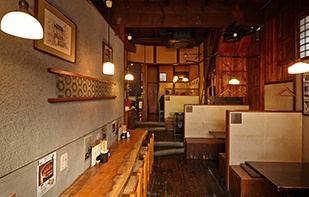
Phone: 03-3272-3227
- Address:
- 2-9-9 Nihonbashi, Chuo-ku, Tokyo
- Open:
- All year round
Mondays to Fridays
Lunch 11:00-14:30 (last order 14:00)
Dinner 17:00-21:30 (last order 21:00)
Saturdays/Sundays/Holidays
Lunch 11:30-15:30 (last order 15:00)
Dinner 16:30-21:00 (last order 20:30)
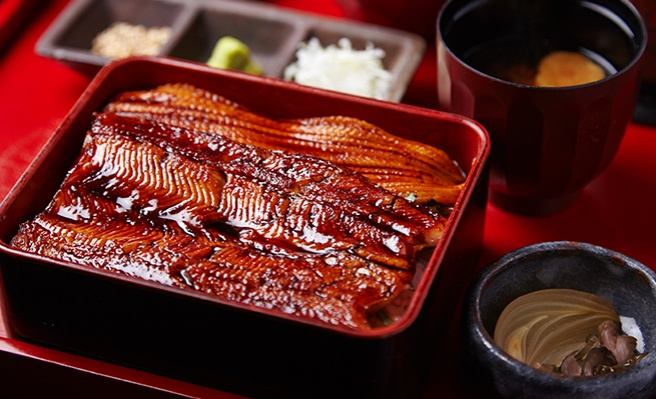
Tamai's signature box meal exemplifies the profound attraction of naturally grown anago. Guests can choose from simmered or grilled anago and are served delicious soup condensed from roasted anago bone stock that can be poured over chazuke following the meal.
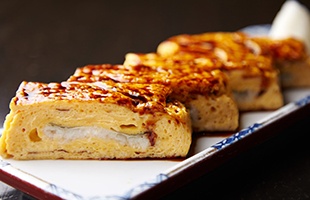
Popular amaki (egg-wrapped anago) is similar to umaki (egg-wrapped unagi eel) and brushed with a flavorful sauce.
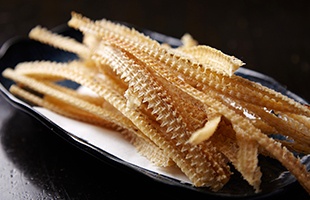
Delightfully crisp anago hone senbei (bone crackers) are roasted, fried and served as a snack with drinks.
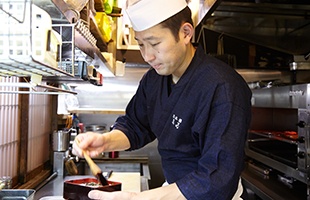
Tamai specializes in anago and simmers massive volumes every day, enabling the creation of a thick and tasty sauce available at no other restaurant.
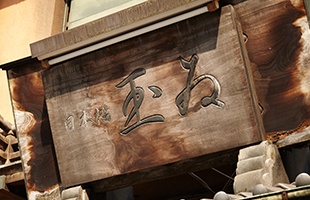
The wooden building was constructed in 1953 and was formerly a home. It serves as a classic setting for Edomae cuisine.
Immerse yourself in anago artistry
Large commercial developments have transformed much of Nihonbashi into a modern, trendy district. But hidden away behind a skyscraper, in a narrow alleyway, is a wooden remnant of the past with the words Nihonbashi Tamai Main Store carved above its entrance. Built after WWII, the building was originally a liquor store and became a residence until 9 years ago when it reopened as a restaurant specializing in anago (conger eel) cuisine.
President Yuji Sato explains “when I discovered this building in Nihonbashi, of all places, it inspired me to open an anago restaurant." The president and every manager that has worked at Tamai are professional sushi chefs with a passion for quality and aesthetics. The old wooden building was the perfect choice for sushi connoisseurs serving anago cuisine.
Tamai’s signature dish is anago hakomeshi (boxed meal) topped with rich, tasty sauce. The simmered anago is so tender that it melts in your mouth. Crispy grilled anago is also available in a set that includes soup and chazuke (rice in tea or broth). “We cook far more anago here than at sushi restaurants and it produces fantastic sauce you can never taste anywhere else,” manager Yujiro Sugimura proudly comments.
Tamai is the consummate anago restaurant. It perfectly represents the ideal of passionate artisans and attracts an endless stream of enchanted guests.

Phone: 03-3272-3227
- Address:
- 2-9-9 Nihonbashi, Chuo-ku, Tokyo
- Open:
- All year round
Mondays to Fridays
Lunch 11:00-14:30 (last order 14:00)
Dinner 17:00-21:30 (last order 21:00)
Saturdays/Sundays/Holidays
Lunch 11:30-15:30 (last order 15:00)
Dinner 16:30-21:00 (last order 20:30)
Myojinshita
Kandagawa
Shiten明神下 神田川支店
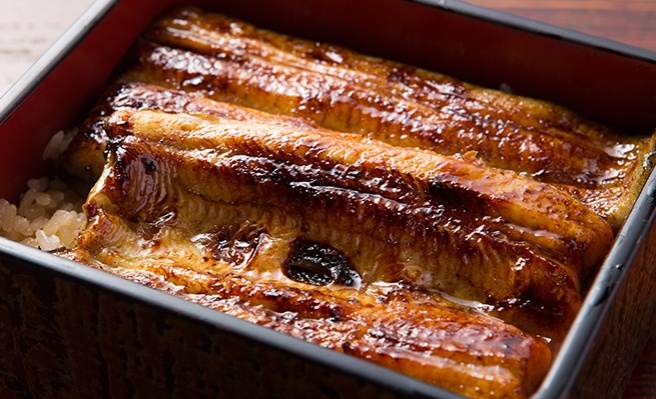
Tender, flavorful unagi brushed with sauce from a secret recipe is served on the finest Koshihikari brand rice from Ibaraki in the unajyu (eel on rice) set. Clear soup, pickles and fruit are also included.
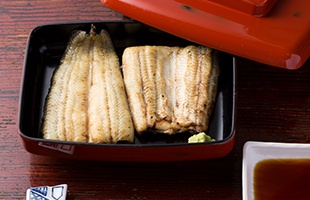
Shirayaki (white grilled unagi) is steamed before roasting. It's delicious whether eaten plain or with soy sauce and wasabi. Prices vary with the size of the eel.
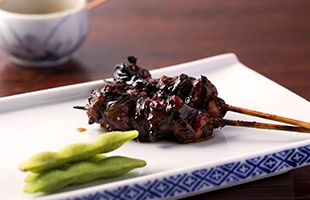
Kimoyaki (grilled eel liver) skewered with fillet and other meat is dipped in sauce before being grilled and served as hors d’oeuvres.
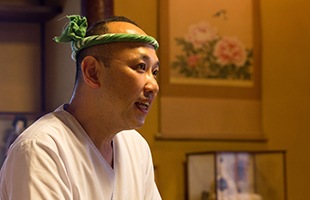
Owner chef Kenichi Tabe in hachimaki (head band) is passionate about his mission, handed down from his father, to serve the finest unagi dishes.
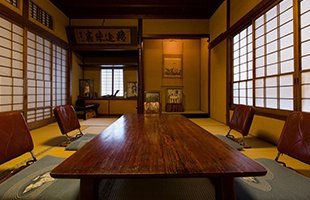
The wooden restaurant, constructed after WWII, consists of four Japanese tatami rooms. Partitions can be removed to accommodate larger parties.
The choice of unagi aficionados
The meat is tender with fat that melts on your tongue. The rich, flavorful sauce is just the right thickness. It's a combination that has made traditionally prepared Edomae unagi (freshwater eel) irresistible to generations of Japanese.
Myojinshita Kandagawa Shiten (branch) has been serving unagi since 1918, when the honten (main restaurant) authorized the founder, an unagi wholesaler with cooking talent, to launch a business under the Kandagawa name and use its original sauce recipe, which the branch is renowned for to this day.
“Unagi tastes best when eaten with rice” claims third-generation owner chef, Kenichi Tabe. “Our sauce is slightly milder than at the honten”. Mild and delicious, the sauce perfectly merges the unagi and rice.
Myojinshita Kandagawa Shiten only serves young domestically cultured shirasu-unagi (glass eel) that is less than a year old. The unagi is skillfully grilled at just the right temperature to become delectably fluffy and tender.
The old building, constructed in 1951, provides a warm, traditional environment with photos of past sumo wrestler guests and comfortable tatami rooms where you can relax and fully enjoy unagi, Japan’s culinary delicacy from the Edo era.
Muromachi
Sunaba室町砂場

Cool tororo (grated yam) soba is served from June to August. The tsuyu is lightened for summer and topped with tororo (grated yam), junsai (water plant), okra and buckwheat grain. Refreshing plum meat, wasabi (Japanese horseradish) and seaweed can be added to taste.
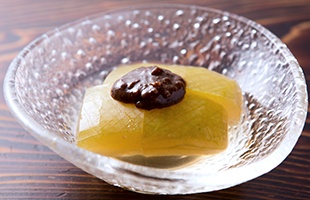
Chilled winter melon topped with chicken miso sauce. The specially prepared sauce makes all the difference in this refreshing summer dish.
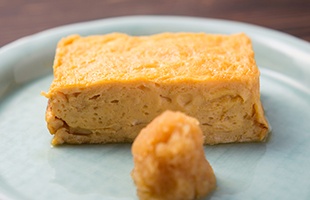
Tamagoyaki (baked egg) is a common sobamae that Sunaba makes special with a delicious tsuyu flavor and a pleasing consistency that wiggles on your plate.
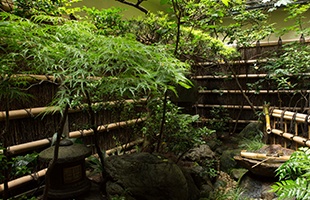
Seasonal beauty is always on display in the courtyard. The restaurant and its grounds were renovated in 2008, but maintain their original atmosphere.
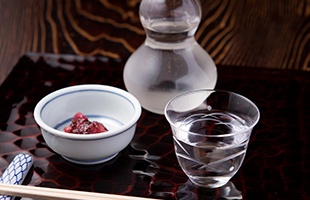
Only the best sake brands for soba are served at Sunaba. Warm sake: Kikumasamune Tokusen. Chilled sake: Kikumasamune Tarusake and Junmaishu Kurabito.
Soba for soba lovers
Thin, light-colored soba noodles glisten on a reed mat. Their aroma fills your nostrils as they slip into your mouth. Muromachi Sunaba only uses flour milled from the very center of buckwheat kernels in its genuine Edomae soba (buckwheat noodles), which have been served the same way since the shop was established in 1869.
The Edomae tsuyu (dipping sauce) served at Sunaba is dark and aromatic. Dipping one end of the noodles is enough to fully savor its flavor and fragrance. Guests have been enjoying the same traditional soba and tsuyu at Sunaba for over a hundred years.
Sunaba never overlooks the details. It uses only the finest buckwheat grain harvested that season and always serves sobamae (before-soba hors d’oeuvres) containing seasonal produce. Yet it never hesitates to add trendy items to the menu. The exceptional skill of its fifth-generation owner keeps even stubbornly traditional customers coming back for more.
From sake served with sobamae to impeccably prepared signature soba, the culinary experience at Sunaba is sophisticated and stylish.
*Articles are written based on information available at the time of publication.
More restaurants



